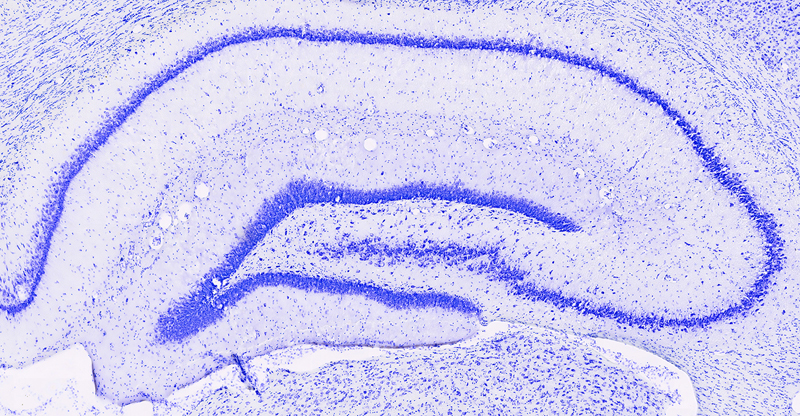
Your brain transmits information about your current location and memories of past locations over the same neural pathways using different frequencies of a rhythmic electrical activity called gamma waves, report neuroscientists at The University of Texas at Austin.
 The research, published in the journal Neuron on April 17, may provide insight into the cognitive and memory disruptions seen in diseases such as schizophrenia and Alzheimer's, in which gamma waves are disturbed.
The research, published in the journal Neuron on April 17, may provide insight into the cognitive and memory disruptions seen in diseases such as schizophrenia and Alzheimer's, in which gamma waves are disturbed.
Previous research has shown that the same brain region is activated whether we're storing memories of a new place or recalling past places we've been.
"Many of us leave our cars in a parking garage on a daily basis. Every morning, we create a memory of where we parked our car, which we retrieve in the evening when we pick it up," said Laura Colgin, assistant professor of neuroscience and member of the Center for Learning and Memory in The University of Texas at Austin's College of Natural Sciences. "How then do our brains distinguish between current location and the memory of a location? Our new findings suggest a mechanism for distinguishing these different representations."
Memory involving location is stored in an area of the brain called the hippocampus. The neurons in the hippocampus that store spatial memories (such as the location where you parked your car) are called place cells. The same set of place cells are activated both when a new memory of a location is stored and, later, when the memory of that location is recalled or retrieved.
When the hippocampus forms a new spatial memory, it receives sensory information about your current location from a brain region called the entorhinal cortex. When the hippocampus recalls a past location, it retrieves the stored spatial memory from a subregion of the hippocampus called CA3.
The entorhinal cortex and CA3 transmit these different types of information using different frequencies of gamma waves. The entorhinal cortex uses fast gamma waves, which have a frequency of about 80 Hz (about the same frequency as a bass E note played on a piano). In contrast, CA3 sends its signals on slow gamma waves, which have a frequency of about 40 Hz.
Colgin and her colleagues hypothesized that fast gamma waves promote encoding of recent experiences, while slow gamma waves support memory retrieval.
 They tested these hypotheses by recording gamma waves in the hippocampus, together with electrical signals from place cells, in rats navigating through a simple environment. They found that place cells represented the rat's current location when cells were active on fast gamma waves. When cells were active on slow gamma waves, place cells represented locations in the direction that the rat was heading.
They tested these hypotheses by recording gamma waves in the hippocampus, together with electrical signals from place cells, in rats navigating through a simple environment. They found that place cells represented the rat's current location when cells were active on fast gamma waves. When cells were active on slow gamma waves, place cells represented locations in the direction that the rat was heading.
"These findings suggest that fast gamma waves promote current memory encoding, such as the memory of where we just parked," said Colgin. "However, when we need to remember where we are going, like when finding our parked car later in the day, the hippocampus tunes into slow gamma waves."
Because gamma waves are seen in many areas of the brain besides the hippocampus, Colgin's findings may generalize beyond spatial memory. The ability for neurons to tune into different frequencies of gamma waves provides a way for the brain to traffic different types of information across the same neuronal circuits.
Colgin said one of the next steps in her team's research will be to apply technologies that induce different types of gamma waves in rats performing memory tasks. She imagines that they will be able to improve new memory encoding by inducing fast gamma waves. Conversely, she expects that inducing slow gamma waves will be detrimental to the encoding of new memories. Those slow gamma waves should trigger old memories, which would interfere with new learning.
Support for this research was provided by the Esther A. and Joseph Klingenstein Fund, the Alfred P. Sloan Foundation and the National Institute of Mental Health.
Colgin's co-authors at The University of Texas at Austin were graduate student Kevin Bieri and research assistant Katelyn Bobbitt.
For more information, contact: Laura Colgin, 512-232-6361, colgin@mail.clm.utexas.edu; Marc Airhart, 512-232-1066, mairhart@austin.utexas.edu
To read the paper "Slow and Fast Gamma Rhythms Coordinate Different Spatial Coding Modes in Hippocampal Place Cells" (Neuron, April 17, 2014) go to: http://www.cell.com/neuron/abstract/S0896-6273(14)00241-4

















Comments 1
great research and a great article. Exciting progress!